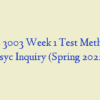Description
PSYC-3003-11-Methods in Psyc Inquiry-QTR-Term- wks-7-thru-12
Test – Week 6
90 out of 90 points
- Jamal decides to compare the lyrics of rock and roll songs in the 1950s and the 1990s. He selects from the top 10 lists for each time period, and compares the lyrics. Jamal’s research method is based upon
- A researcher tests the effects of a skills enhancement program by measuring the change in social adjustment of a group of handicapped children before and after they have completed the program against a change in adjustment over the same time period for an equivalent group of children who had not participated in any therapy. The children who went through the program showed significantly greater increase in social adjustment functioning over time. The research design is
- A limitation of program evaluation research is its
- Which of the following research approaches is most likely to allow the researcher to develop close friendships with the people being studied?
- Research designed to study intervention programs with the goal of determining whether the programs are effective in helping the people who make use of them is called
- In comparison to the single-group before-after design, the comparison-group before-after design
- Event sampling, individual sampling, and time sampling are all used in
- A flight instructor notices an unusual phenomenon. Every time one of her students has a particularly excellent flight, she praises them for it. And she notices that the next time the student flies, he or she ends up doing worse. On the other hand, every time one of her students has a particularly poor flight, she criticizes them, and the next time they do better. What phenomenon might the instructor be seeing?
- When it comes to controlling over the conditions in the experiment or over the assignment of participants to groups in the experiment, a researcher in a natural setting is likely to have
- An experimenter is interested in the influence of taking a one-semester-long test preparation course on performance on the Scholastic Aptitude Test (SAT). She contacts high school students who have and who have not taken the course and compares their scores on the SAT exam. She finds that the students who have taken the course score significantly higher on the test. Which of the following represents the principal threat to the internal validity of this experiment?
- When individuals’ performance on a posttest differs from their initial testing not because of treatment but because of familiarity with the measure a threat to internal validity is likely.
- Buchanan, Tranel, and Kirschbaum (2009) compared three groups of participants, one of which had damage to the hippocampus, one that had similar brain damage but not to the hippocampus, and a control group of participants. The researchers assessed the responses of the three groups both before and after they were exposed to stress. The hippocampus group showed less change in cortisol response to stress than the other two groups. What research design was used in this research?
- Helen and her team of observers were hired by a corporation to examine work productivity. Each observer focused on a single worker for a period of 30 minutes before moving on to observe another worker. This is an example of which of the following sampling methods?
- Which of the following is least likely to be a threat to validity in a single group before- after design?
- A researcher who simply watches behavior at a public children’s playground to learn about toddler play behavior is using one of the following techniques.
- Systematic observation and content coding of archival data both normally make use of which of the following techniques?
- In a single-group before-after research design, changes that occur in the participants over time but which are not related to the independent variable are known as which of the following?
- Quasi-experimental research designs are so named because
- Which of the following are most likely to be used in naturalistic research?
- What type of research method assesses changes in behavior in one group of subjects at more than one point in time?
- Which of the following represents the greatest limitation to drawing conclusions from a single-group quasi-experimental design?
- Nancy and her team of observers wish to collect data on “aggressive play” that occurs on an elementary school playground during recess. Rather than trying to record all of the children’s behaviors on the playground, each member on Nancy’s team is randomly assigned one child on the playground to observe for the entire duration of the recess. This is an example of which of the following sampling methods?
- Which of the following is an example of a single-group research design?
- Content analysis refers to
- Which of the following statements is true about quasi-experimental designs?
- Students were given a pretest when their math class began and a posttest at the end of the semester. The student’s math performance increased. The teacher learned near the end of the semester, however, that in their science classes, the students were using new computer software that included much of the math the teacher was covering in his course. Which of the following threats to internal validity does the new computer software represent?
- Which of the following could not represent a participant variable?
- To observe behaviors in social situations that might occur infrequently, researchers choose
- Relying upon detailed descriptions of a single individual is known as the method.
- Which of the following three approaches are used to reduce the amount of data that needs to be recorded in naturalistic observation?
- Regression to the mean causes interpretive difficulties when
- An experimenter decided to test the effects of a new training program by comparing the motivation of 20 employees who had participated in the program against an equivalent group of 20 employees who had not gone through any training at all. The employees were measured when they had completed the program and it was found that those who had gone through the program had much greater on-the-job motivation than those who had not. It was concluded that the difference in motivation was due to the content of the training program. The quasi-experimental research design is
- In order to reduce observer bias in an observational research design, a researcher might
- A design in which behavior is initially measured during a baseline period, measured again after the intervention of interest begins, and then measured once more after the intervention is removed is called a
- An advantage of a single-participant design is that
- A design in which behavior is initially measured during a baseline period and then measured again after the intervention of interest begins is called a
- A researcher is unable to retest some of his participants in a before-after design because they have dropped out of the program. This is an example of a(n) threat.
- Which of the following research approaches is most likely to have ethical problems?
- An experimenter is interested in the influence of taking a one-semester-long test preparation course on performance on the Scholastic Aptitude Test (SAT). She contacts high school students who have and who have not taken the course and compares their scores on the SAT exam. She finds that the students who have taken the course score significantly higher on the test. The appropriate statistical test is
- In quasi-experimental research, longitudinal designs are to cross-sectional designs as
- One of the main ways that true experiments differ from quasi-experiments is that true experiments use
- Joe decides to study how insects behave in their everyday life. He watches some ladybugs in his backyard and codes whether they are either living alone, living in groups, or living in pairs. Joe’s observational system is based on the use of which of the following?
- Which of the following is NOT a quasi-experimental research design?
- A study of parenting styles across generations samples groups of participants at ages 5, 15, and 20 at the same time. Which of the following terms best describes this design?
- It is most accurate to say that




